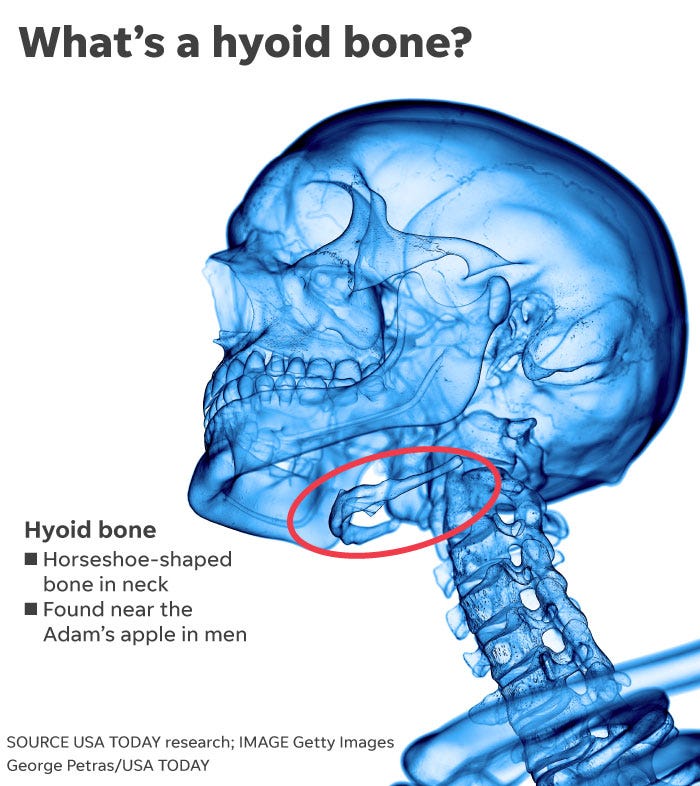General Discussion
Related: Editorials & Other Articles, Issue Forums, Alliance Forums, Region ForumsEpstein's Broken Hyoid Bone Doesn't Tell Us Much
SlateYes, the hyoid—the U-shaped bone located at the top and front of the neck—is more likely to be broken when a person has been strangled than if they were hanged. But the hyoid is also broken in hangings—possibly infrequently, and possibly often. There’s no agreement in the forensics community on exactly how frequently, but it is known to occur and is not considered remarkable.
Here’s some basic math. Each year, around 16,000 men are murdered in the United States. Of those, approximately 385 are strangled (2.4 percent). Meanwhile, around 35,000 men die by suicide, 8,000 (23 percent) of those by hanging. This means that if a medical examiner encounters a random dead body (but no other information), it is over 20 times more likely that the man died by hanging than by strangulation. Even after the discovery of a broken hyoid bone, the overall odds would still heavily favor hanging, even though the rate of hyoid bone fracture is indeed somewhat higher in strangulation, because broken hyoid bones aren’t 20 times more likely to be broken during strangulation than hanging. Not even close.
If a broken hyoid bone was rarely or never associated with death by hanging, then there might be something here. But in the study cited by the Washington Post itself, 25 percent of patients who died by suicidal hanging had broken hyoids. That’s not a small number. Also, the average age of patients with this finding was 61 (Epstein was 66), much older than those in the study without broken hyoids.
...snip...
If investigators discovered a dead body slumped on the ground in a private home with no obvious cause of death, the situation would be rather different. No noose? No rope marks around the neck? No suicide note? No history of depression or recent traumatic life changes? Sure, in that case discovering a broken hyoid might correctly move detectives toward a murder investigation. But the known facts of Epstein’s death, the known circumstances that he had indeed recently lost everything and stood little chance of redemption, matter greatly. Finding a broken hyoid bone on the autopsy is hardly a Columbo moment. Given the statistics, and given the context, it remains far more likely that Epstein broke his hyoid while killing himself than that it was broken as he was murdered.
Jeremy Samuel Faust is an emergency medicine physician at Brigham and Women’s Hospital in Boston, faculty in its division of health policy and public health, and an instructor at Harvard Medical School. He is the co-host of FOAMcast and the board president of the Grammy Award–winning vocal ensemble Roomful of Teeth.
jberryhill
(62,444 posts)The thing is, it is extremely unlikely that, once the autopsy is complete and in the event it determines suicide, that any major media is going to publish a diagram of the manner in which he was found or carried out the act.
Why?
For precisely the reasons you state. Suicide is very common, and the second most common form (behind firearms) is some form of "hanging" or suffocation.
When most people think of hanging, they think of the gallows-type execution method where the drop of the body breaks the neck (the vertebra, not just the hyoid bone), or they think of the suspension method where someone ties the ligature to a high point and steps off of a chair or other support.
You can suffocate yourself to death through some form of strangulation with less than 20 pounds of force.
People seem to believe that the bone in question is some major structural bone in the neck. It's not. It's a little horseshoe shaped bone here:

It likewise doesn't require a tremendous amount of force to break, as it is in a very well protected position behind and below the jaw. Unless, of course, someone is choking you, or you have arranged to have something tighten around your throat and are leaning forward into it.
But none of that matters.
Because major media is unlikely to publish "Hey kids, try killing yourself this way!" for the obvious reasons, then it will always be possible to claim that the real story is being covered up.
Hoyt
(54,770 posts)Wounded Bear
(58,676 posts)Apparently, you can find instructions online. If you do it right, it starts off as something much like the "sleeper" hold you see on some of the crime fighter shows. They use that a lot on NCIS-LA. It's real, they tried to teach us that in boot camp in 1970. IAE, the person drifts into unconsciousness and then death.
![]()
Nay
(12,051 posts)including the hyoid. Is that not true? Do most kneeling suffocations break several other bones in the neck?
flotsam
(3,268 posts)They said bones (plural) so how many and which ones were they? I'm tired of endless discussions of the hyoid-give us the whole autopsy report. Otherwise the coverup continues.
TexasBushwhacker
(20,205 posts)I would think it would take considerable force to cause fractures in them.
Nay
(12,051 posts)vertebrae fractured, how much less likely was this a suicide? I know the hyoid is fragile and easily broken, but vertebrae aren't.
It would be nice if they would outright tell you only the hyoid was broken and the first report was wrong. But no one has said a damn thing about the first report, so I'm still wondering what the hell is going on with the autopsy.